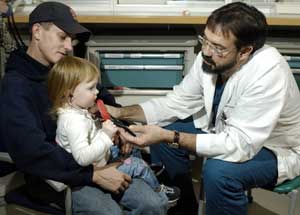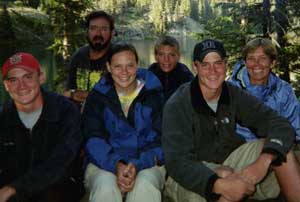At one time, pediatric emergency medicine physician Robert M. “Bo” Kennedy, M.D., could guess, without even looking, how many patients were waiting for treatment in the St. Louis Children’s Hospital Emergency Department. The loud cries of these frightened children, many of them in pain, always tipped him off.
With his trademark intensity, Kennedy decided they could do better. So in his research projects, he began to focus on alleviating children’s anxiety and suffering from the moment they enter the hospital. Thanks to a range of regimens that he has developed in collaboration with colleagues in anesthesiology and psychiatry, the noise level in his department has noticeably tapered off.

“I really think that we have worked hard to become the ‘ouchless emergency department,'” says Kennedy, who is also an associate professor of pediatrics. Along the way, some of his innovations have changed emergency room treatment worldwide.
“Bo Kennedy is simply one of the finest pediatric emergency physicians in practice today,” says David M. Jaffe, M.D., head of the division of pediatric emergency medicine. “He is passionate about alleviating the pain and anxiety of children in the emergency department and has become a leader in clinical investigation in this area. Bo was here before our division existed, and we are fortunate to have benefited from his many contributions over the past 20 years.”
Among the treatments that Kennedy has pioneered is the use of buffered lidocaine — injected with tiny, 30-gauge needles — to blunt the pain of starting an intravenous line. Even sleeping babies only stir a little but don’t awaken when he hooks them up.
Another is the combination of two drugs, ketamine and midazolam, which he tested in children with forearm fractures who needed a painful bone realignment. The results were clear: ketamine worked better and caused fewer breathing complications than earlier drug combinations. Over time, the staff began using IV-administered ketamine for a variety of serious procedures, such as treating burns.
“But there were more minor procedures, such as suturing lacerations, where we really only needed a local anesthetic and lighter sedation,” he says. “Using ketamine seemed like using a sledgehammer when a tack hammer would do.”
Working with colleague Janet D. Luhmann, M.D., assistant professor of pediatrics, Kennedy began to take a fresh look at nitrous oxide or “laughing gas,” often used in dental procedures. In small children with facial lacerations, was it as effective as midazolam or did the two work best together? The nitrous oxide had joyous results.
“One 2-year-old with facial lacerations was screaming at the idea of putting on topical anesthetic gel, but when he was given the nitrous oxide, his screams turned into giggles,” Kennedy says. “Then his mother, who was standing at the bedside trying to calm him, started laughing — and all the tension just melted away.”
Building on this work, he has tested nitrous oxide for other purposes, most recently for fractured forearms, in conjunction with injected lidocaine. Again, this combination was as effective — and easier on the child — than the ketamine and midazolam. Because forearm fractures account for three-quarters of all broken bones that need to be realigned, this finding has “a big impact,” he says.

Reducing a patient’s suffering has sometimes taken a common-sense approach. When children walk into the emergency room, they may be in pain from a broken bone or cut. By the time they get into a room, some 30-60 pain-filled minutes may have elapsed.
“We set up standing orders for the nurses in triage to administer a pain medicine, oxycodone, even before the patient goes to X-ray,” Kennedy says. “That can be one of the most painful parts of the visit, because the technologist has to move the broken limb to get different views. With the oxycodone kicking in, kids are in much less pain.”
Even non-pharmacologic changes can have a major effect. Recently, Kennedy worked with colleagues to complete a study showing that children who sit on their mothers’ laps instead of lying on a stretcher do not need sedation while the medical team starts an IV or stitches up their cuts.
“I enjoy making the hospital a better experience for my patients,” says Kennedy, who works days, nights, even 2-3 overnight shifts each month. “That’s what attracted me to medicine — service to others. I can’t imagine doing anything else.”
Kennedy’s own childhood, spent in Virginia and Georgia, charted the course for his career. From his father, a Presbyterian minister, he learned a philosophy that has seen him through many a long night: When you’re interacting with people, work on the assumption that they are doing the best they can, all things considered.
“That has helped me address, at 3 in the morning, a mom whose child has a problem that has been going on for weeks or months,” he says. “Why tonight? There must be something that I’m missing, rather than ‘she’s here to punish me.’ It helps you get past the judgmental baggage and focus on the problem at hand.”
The rest of his family also had an influence. From his mother, an elementary school teacher, he picked up a love for children, and from his older brother Monty, a pediatrician in Dallas, he acquired a nickname: “Bo,” a childhood mangling of the word “brother.”
With that brother, he undertook a 5,200-mile, cross-country bicycle trip in June 1976, just after he graduated from Georgia Institute of Technology and before he went off to the Medical College of Georgia.
He left Georgia to come to Children’s Hospital for his pediatric training and, in 1983, inaugurated the field of emergency medicine there, as the first faculty member with a full-time presence in the emergency department.
“As I rotated through all of the subspecialties in pediatrics, I was seduced by each and every one. I loved newborn medicine, pediatric cardiology, endocrinology,” he says. “Soon I realized that I didn’t want to focus on one, excluding the others. What they say about emergency medicine is that we’re experts in the first 20 minutes of everybody else’s subspecialty. It necessitates keeping up with a broad area.”
|
Robert M. “Bo” Kennedy University title: Associate professor of pediatrics Clinical and teaching duties: Workin gas an attending physician in the Emergency Unit at St. Louis Children’s Hospital, where he serves as a preceptor for pediatric house staff and medical students rotating through the unit. In addition, Kennedy coordinates the Pediatric Emergency Medicine Conference; is medical director of Pediatric Advanced Life Support; director of the Suture Nurse Program; and coordinator of the Pediatric Grand Rounds Conference for Adult Emergency Medicine Residents. Research interests: Evaluation and reduction of pain and distress in pediatric emergencies, sedation techniques and laceration repair in young children. |
One year after he joined the faculty, his brother returned with an irresistible proposal: cycling to Alaska to visit their sister. This time, Kennedy invited his girlfriend, a pediatric nurse, to join them and she said yes — both to the trip and to a wedding. The 3,000-mile trek became their honeymoon; once in Alaska, they spent a year working and having outdoor adventures.
Back in St. Louis, Kennedy rejoined his old division, where he has since held administrative roles: organizing its educational program as associate director for educational affairs; and directing the Pediatric Advanced Life Support Program. From 2003-05, he served as medical staff president, working with anesthesiologist John D. McAllister, M.D., to create a pain and sedation subcommittee. He also helped develop some of the original trauma center regulations for the state of Missouri.
Kennedy and his wife, Carol, have four children: twins Greg and Scott, 19, both freshmen at Washington University; Julie, 16; and David, 13. The Glendale-based family enjoys backpacking vacations — the more rigorous, the better.
“Once we went off and laid on a beach, and everybody got real bored by that,” says Kennedy, who commutes to work by bicycle several times a week.
Research still beckons, especially the idea of tailoring pain management to a patient’s preference. Trying to determine exactly which child will do best with which medication is a long-term goal. How long will it take to do it right?
“A lifetime,” he says, anticipating the challenge.